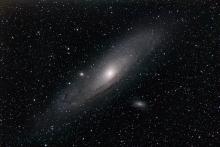Listen to today's episode of StarDate on the web the same day it airs in high-quality streaming audio without any extra ads or announcements. Choose a $8 one-month pass, or listen every day for a year for just $30.
You are here
Galactic Twin
One of the highlights of the autumn sky is M31, the Andromeda Galaxy. It’s the most distant object that’s readily visible to the unaided eye — about two-and-a-half million light-years away.
M31 and our own galaxy, the Milky Way, are near twins.
Both are spiral galaxies. They’re shaped like wide, thin disks. Their hottest, brightest stars outline spiral arms, so from afar, the galaxies look like pinwheels. The Milky Way spans about a hundred thousand light-years, while Andromeda is bigger.
Both galaxies are at least a trillion times as massive as the Sun. Astronomers used to think that Andromeda was the heavier of the two, but recent work seems to give the nod to the Milky Way.
Each galaxy has several hundred billion stars. But most of their mass is in the form of dark matter. It produces no detectable energy. But we know it’s there because it exerts a gravitational pull on the stars and gas around it.
The dark matter is concentrated in vast “halos” that surround the galaxies — ball-shaped volumes of space that contain few stars. Andromeda’s halo may extend a half-million light-years from the galaxy’s heart — a long way toward the Milky Way. Over the eons, the two galaxies will get even closer. Eventually, they’ll merge — one monster galaxy instead of two giant ones.
M31 is high in the east-northeast by the time it gets nice and dark. It looks like a small, fuzzy patch of light, so you need to get away from city lights to see it.






